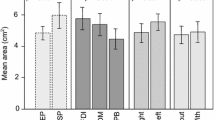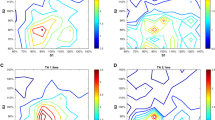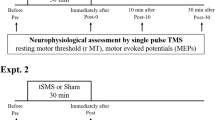Abstract
Non-invasive transcranial magnetic stimulation (TMS) of motor cortex induces motor evoked potentials in contralateral muscles which are thought to be conducted by the corticospinal tract. Furthermore, inhibitory actions can be elicited by TMS which appear directly after the motor evoked potential (postexcitatory inhibition, PI) and can be visualized by blockade of tonic voluntary EMG activity. It was the aim of the present study to answer the questions of whether this inhibitory action is mainly of cortical or of spinal origin, which brain area generates this inhibition, and whether the duration of PI differs between proximal and distal muscles. Experiments were performed on a total of 34 healthy volunteers. Brain stimuli were delivered with a Novametrix Magstim 200HP with a maximum output of 2.0 T, and stimulation was performed during tonic voluntary activation of the muscle under study. Stimulation strength was 1.5 times threshold level. Duration of PI was defined as the time from the onset of the motor evoked potential to the reoccurrence of the EMG background activity. PI was found more pronounced in distal hand muscles than in proximal arm and leg muscles. The largest PI values were observed when the primary motor cortex was stimulated. To test the excitability of the spinal motoneurones during PI, cortical double stimulation at various intervals was performed and the soleus H-reflex was evoked at different intervals after cortical stimulation. Neither test revealed a decrease in the excitability of the spinal motoneurones during PI. These findings imply that spinal segmental inhibitory action cannot account for PI and that, most probably, inhibitory actions within the motor cortex play a major role in the genesis of PI.
Similar content being viewed by others
References
Amassian VE, Stewart M, Quirk GJ, Rosenthal JL (1987) Physiological basis of motor effects of a transient stimulus to the cerebral cortex. Neurosurgery 20:74–92
Avoli M (1986) Inhibitory potentials in neurons of the deep layers of the in vitro neocortical slice. Brain Res 370:165–170
Barker AT, Jalinous R, Freeston IL (1986) Non invasive magnetic stimulation of the human motor cortex. Lancet I: 1106–1107
Benecke R, Meyer BU, Schönle P, Conrad B (1988) Transcranial magnetic stimulation of the human brain: responses in muscles supplied by cranial nerves. Exp Brain Res 71:623–632
Benecke R, Meyer BU, Freund HJ (1991) Re-organisation of descending motor pathways in patients after hemispherectomy and severe hemispheric lesions demonstrated by magnetic brain stimulation. Exp Brain Res 83:419–426
Berardelli M, Inghilleri M, Cruccu G, Fornarelli M, Accornero N, Manfredi M (1988) Stimulation of motor tracts in multiple sclerosis. J Neurol Neurosurg Psychiatry 51:677–683
Boyd SG, Rothwell JC, Cowan JMA, Webb PJ, Morley T, Asselman P, Marsden CD (1986) A method of monitoring function in corticospinal pathways during scoliosis surgery with a note on motor conduction velocities. J Neurol Neurosurg Psychiatry 49:251–257
Connors BW, Malenka RC, Silva LR (1988) Two inhibitory postsynaptic potentials, and GABAA and GABAB receptor-mediated reponses in neocortex of rat and cat. J Physiol (Lond) 406:443–468
Creutzfeldt OD, Baumgartner G, Schoen L (1956) Reaktionen einzelner Neurone des senso-motorischen Cortex nach elektrischen Reizen. I. Hemmung und Erregung nach direkten und kontralateralen Reizen. Archiv Psychiatr Z Neurol 194:597–619
Davey NJ, Romaiguere P, Maskill DW, Ellaway PH (1992) Inhibition of voluntary contraction by transcranial magnetic stimulation of the brain subthreshold for excitation in man. J Physiol (Lond) 446:447P
Day BL, Dressler D, Maertens de Noordhout A, Marsden CD, Nakashima K, Rothwell JC, Thompson PD (1989a) Electric and magnetic stimulation of human motor cortex: surface EMG and single motor unit responses. J Physiol (Lond) 412:449–473
Day BL, Rothwell JC, Thompson PD, Maertens de Noordhout A, Nakashima K, Shannon K, Marsden C (1989b) Delay in the execution of voluntary movement by electrical or magnetic brain stimulation in intact man. Brain 112:649–663
Edgley SA, Eyre JA, Lemon RN, Miller S (1990) Excitation of the corticospinal tract by electromagnetic and electrical stimulation of the scalp in the macaque monkey. J Physiol (Lond) 425:301–320
Fuhr P, Agostino R, Hallett M (1991) Spinal motor neuron excitability during the silent period after cortical stimulation. Electroencephalogr Clin Neurophysiol 81:257–262
v. Giesen HJ, Roick H, Benecke R (1993) Pathophysiologic aspects of postexcitatory inhibition. Electroencephalogr Clin Neurophysiol (in press)
Hahne M, Illert M, Wietelmann D (1988) Recurrent inhibition in the distal cat forelimb. Brain Res 456:188–192
Hess CW, Mills KR (1986) Low threshold motor units in human hand muscles can be selectively activated by magnetic brain stimulation. J Physiol (Lond) 380:62P
Hess CW, Mills KR, Murray NMF (1987) Responses in small hand muscles from magnetic stimulation of the human brain. J Physiol (Lond) 388:397–419
Hörner M, Illert M, Kümmel H (1991) Absence of recurrent axon collaterals in motoneurones to the extrinsic digit extensor muscles of the cat forelimb. Neurosci Lett 122:183–186
Illert M, Wietelmann D (1989) Distribution of recurrent inhibition in the cat forelimb. Prog Brain Res 80: p 273
Iversen LL, Mitchell JF, Srinivasan V (1971) The release of γaminobutyric acid during inhibition in the cat visual cortex. J Physiol (Lond) 212:519–534
Kerneil D, Wu CP (1967) Responses of the pyramidal tract to stimulation of the baboon's motor cortex. J Physiol (Lond) 191:653–672
Krnjevic K (1974) Chemical nature of synaptic transmission in vertebrates. Physiol Rev 54:418–540
Krnjevic K (1987) GABAergic inhibition in the neocortex. J Mind Behav 8:537–547
McCormick, DA (1989) GABA as an inhibitory neurotransmitter in human cerebral cortex. J Neurophysiol 62:1018–1027
Merton PA, Morton HB (1980) Stimulation of the cerebral cortex in intact human subject. Nature 285:227
Ottersen OP, Storm-Mathisen J (1984) Glutamate and GABA-containing neurons in the mouse and rat brain as demonstrated with a new immunocytochemical technique. J Comp Neurol 229:374–392
Patton HD, Amassian VE (1954) Single- and multiple-unit analysis of cortical stage of pyramidal tract activation. J Neurophysiol 17:345–363
Pierrot-Deseilligny E, Bussel B, Held JP, Katz R (1976) Excitability of human motoneurones after discharge in a conditioning reflex. Electroencephalogr Clin Neurophysiol 40:279–287
Ribak CE (1978) Aspinous and sparsely spinous stellate neurons in the visual cortex of rats contain glutamic acid decarboxylase. J Neurocytol 7:461–478
Rothwell JC, Thompson PD, Day BL, Dick JPR, Kachi T, Cowan JMA, Marsden CD (1987) Motor cortex stimulation in intact man. 1. General characteristics of EMG response in different muscles. Brain 110:1173–1190
Schwindt PC, Calvin WH (1972) Membrane potential trajectories between spikes underlying motoneurone firing rate. J Neurophysiol 35:311–325
Shahani BT, Young RR (1973) Studies of the normal human silent period in: JE Desmedt (ed). New developments in electromyography and clinical neurophysiology, vol 3. Karger, Basel, pp 589–602
Tseng GF, Haberly LB (1988) Characteristics of synaptically mediated fast and slow inhibitory processes in piriform cortex in an in vitro slice preparation. J Neurophysiol 59:1352–1376
Author information
Authors and Affiliations
Additional information
Dedicated to the memory of Prof. Dr. O. Creutzfeldt
Rights and permissions
About this article
Cite this article
Roick, H., von Giesen, H.J. & Benecke, R. On the origin of the postexcitatory inhibition seen after transcranial magnetic brain stimulation in awake human subjects. Exp Brain Res 94, 489–498 (1993). https://doi.org/10.1007/BF00230207
Received:
Accepted:
Issue Date:
DOI: https://doi.org/10.1007/BF00230207




